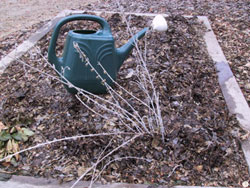During drought, some perennials are short, growing slowly if at all, and perhaps showing leaf scorch and even dieback. Drought tolerant perennials may be in better condition. 
With stressed perennials in situations with little available water, consider cutting them back partially in the fall. Let the plants self-mulch for the winter and hope for winter moisture.
If the fall and winter watering is permitted and perennials are in relatively good condition, the choice of cutting back in fall or spring is no different than other years.

Mulching should benefit any perennial in winter. As always, delay mulching until soil temperatures have cooled, usually in November at lower elevations. Mulch will retain soil moisture and serves to prevent frost heaving that cracks soil and exposes roots to drying.
Winter watering, if permissible, should help survival of perennials. Water on warm days when temperatures are over 40 degrees. Apply water at mid-day so it will have time to soak in before possible freezing at night. Water monthly in winter. If winter precipitation does add to soil moisture, a monthly winter watering can be delayed or skipped.
For more information, see the following Colorado State University Extension fact sheet(s).
- Perennial Gardening
- Fall and Winter Watering
- Mulches for Home Grounds
- Herbaceous Perennials
- Flowers for Mountain Communities
For more information, see the following Planttalk Colorado™ script(s).



